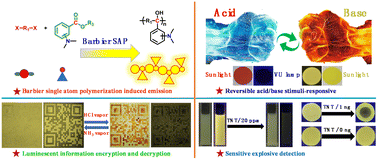Barbier single-atom polymerization induced emission as a one-pot approach towards stimuli-responsive luminescent polymers†
Abstract
Stimuli-responsive luminescent polymers play important roles in polymer science and are generally designed through polymerization or post-polymerization modification with both stimuli-responsive and luminescent moieties, which involves multistep synthetic procedures. Here, we demonstrate a one-pot strategy for the molecular design of stimuli-responsive luminescent polymers through Barbier single-atom polymerization-induced emission (PIE). The incorporation of the N,N-dimethyl moiety into the polymer chain endows the polymers with both stimuli-responsive and red-shifted nonconjugated emission properties. This nonconjugated luminescence is revealed with the through-space conjugation effect caused by polymer chain entanglement. The prepared stimuli-responsive luminescent polymers exhibit intriguing substitution position related structure–property relationships, where only para N,N-dimethyl substituted polymers exhibit acid/base responsive properties. Further applications in ng level explosive detection on test paper and luminescent encryption are carried out as well. This work therefore opens a new avenue for the molecular design of stimuli-responsive luminescent polymers in one pot, which expands the methodology and structure libraries of stimuli-responsive luminescent polymers.

- This article is part of the themed collection: Polymer Chemistry Recent HOT Articles


 Please wait while we load your content...
Please wait while we load your content...